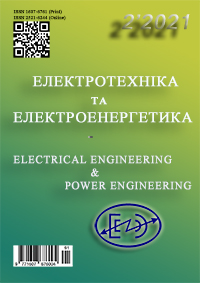Vector control system of electric drive of grain machine conveyor
DOI:
https://doi.org/10.15588/1607-6761-2021-2-1Keywords:
grain-throwing machines, conveyor electric drive, vector control, speed regulation, quality indicatorsAbstract
Purpose. Synthesis of an automatic control system for an asynchronous electric drive of a grain thrower conveyor based on a frequency converter with vector control.
Methodology. The research was carried out using methods of mathematical modeling of an electric drive; using methods of tuning optimization and regulator synthesis. The technique of synthesis of vector control systems is based on the representation of a non-stationary multi-connected object, which is an AC machine, in the form of a set of stationary subobjects with linear links in the main control channels.
Findings. The study of the work of the subordinate regulation system, which implements the principles of vector control, oriented along the vector of the rotor flux linkage, has been carried out. The modeling of the processes of AM excitation, AM start-up at idle speed, nominal load surge, speed reduction has been carried out. It was found that the synthesized system is characterized by good quality indicators. The overshoot at start does not exceed 5%, the regulation time is 0.4 s, the torque limitation is carried out at a predetermined level. It has been proven that oscillatory processes in transient modes with significant torque surges with classical settings of loop regulators can be compensated by introducing artificial cross-links into the control part of the electric drive.
Originality. A system of subordinate regulation of the blood pressure of the grain thrower trimmer conveyor has been implemented to set the speed of the grain flow with the aim of throwing grain at a given distance by creating an appropriate ballistic flight trajectory, which ensures a reduction in losses from damage to grain.
Practical value. The structure of the vector control system of a frequency-controlled asynchronous electric drive with additional compensating cross-connections between active and reactive energy control channels is proposed to improve the quality indicators of the system.
References
Urbaniak, Z. (2004). Wplyw mechanicznych uszkodzen na zdolnosc kielkowania ziama i wschody pszenicy i jeczmienia. Biul. Inst. Hodowli Aklimat. Rosl, 161, 23–34. (in Polish).
Skrinnik, І.Yu., Pіsar'kova, І.O., Petrenko, M.M. (2008). Mekhanіchne travmuvannya zerna [Me-chanical injury of grain]. Design, manufacture and operation of agricultural machinery, 48, 143–153. (in Ukrainian).
Shuhanov, S.N., Tokmakova, A.L. (2013). Obzor kon-struktsiy zernometatel'nykh mashin [Overview of grain throwing machine designs]. Bulletin of IrG-SKhA, 59, 111–115. (in Russian).
Gol'tyapin, V.Ja., Zhalnin, Je.V., Fedorenko, V.F. (2003). Mashiny i oborudovanie dlya posleuborochnoy obrabotki zerna: katalog [Ma-chines and equipment for post-harvest grain pro-cessing: catalog]. М.: FGNU Rosinformagroteh, 202. (in Russian).
Khankhasaev, G.F., Shukhanov, S.N. (2010). Klassi-fikatsiya zernometatel'nykh mashin [Grain throwing machine classification]. Agricultural machinery, 4, 42–44. (in Russian).
https://bim-agritech.com/uk/zernometalnyky-ta-zernonavantazhuvachi
Burdilna, E.V., Serhiienko, S.A. (2021). Pіdvishchennya efektivnostі transportuvannya і perevantazhennya zerna metal'nimi mashinami sіl's'kogospodars'koi tekhnіki [Improving the effi-ciency of transportation and reloading of grain with metal machines of agricultural machinery]. Priority directions of science and technology development. Proceedings of X International Scientific and Prac-tical Conference Kyiv, Ukraine, 13-15 June 2021, 206–212. (in Ukrainian).
Burdilna, E.V., Chornyi, O.P., Tytiuk, V.K., Serhiienko, S.A. (2021). Sintez zakonu keruvannya elektro-privodom ventilyatora zernokidacha dlya fokusu-vannya zernovogo potoku [Synthesis of the law of control of the electric drive of the fan of the grain thrower for focusing of a grain stream]. World Sci-ence journal, 5, 66, 4–13. DOI: 10.31435/rsglobal_ws/30052021/7584. (in Ukrainian).
Wu, B., Mehdi, N. (2017). Other Multilevel Voltage Source Inverters. Wiley-IEEE Press, 185–223.
Bouchiker, S., Capolino, G.-A., Poloujadoff, M. (1998). Vector control of a permanent-magnet syn-chronous motor using AC-AC matrix converter. IEEE Transactions on Power Electronics, 13, 6, 1089–1099. DOI: 10.1109/63.728336.
Yerraguntla, Shasi Kumar, Gautam, Poddar (2018). Medium-Voltage Vector Control Induction Motor Drive at Zero Frequency Using Modular Multilevel Converter. IEEE Transactions on Industrial Electronics, 65, 1, 125–132. DOI: 10.1109/TIE.2017.2721927.
Vijayagopal, M., Silva, C., Empringham, L., Lillo, L. (2019). Direct Predictive Current-Error Vector Control for a Direct Matrix Converter. IEEE Transactions on Power Electronics, 34, 2, 1925–1935. DOI: 10.1109/TPEL.2018.2833495.
Slezhanovskij, O.V., Dackovskij, L.H., Kuzne-cov, I.S. et al. (1983). Sistemy podchinennogo reguli-rovaniya elektroprivodov peremennogo toka s ven-til'nymi preobrazovatelyami [Slave control systems for AC drives with valve converters]. М.: Ener-goatomizdat, 256. (in Russian).
Rudakov, V.V., Stolyarov, I.M., Dartau, V.A. (1987). Asinkhronnye elektroprivody s vektornym upravlen-im [Asynchronous electric drives with vector control]. L.: Energoatomizdat, 136. (in Russian).
Astrom, K.J., Hagglund, T. (2006). Advanced PID control. ISA – The Instrumentation, Systems, and Au-tomation Society, 460.
Li Y., Ang, K., Chong, G. (2006). Patents, software, and hardware for PID control. An overview and analysis of the current art. Control Systems, 26, 41–54.
Vilanova, R., Arrieta, O., Ponsa, P. (2018). Robust PI/PID controllers for load disturbance based on di-rect synthesis. ISA Transactions, 81, 177–196. DOI: 10.1016/j.isatra.2018.07.040.
Errouissi, R., Al-Durra, A., Muyeen, S.M. (2018). Experimental Validation of a Novel PI Speed Con-troller for AC Motor Drives With Improved Transient Performances. IEEE Transactions on Control Systems Technology, 26, 4, 1414–1421. DOI: 10.1109/TCST.2017.2707404.
Downloads
Published
How to Cite
Issue
Section
License
Copyright (c) 2021 Евгения Бурдильная, Сергей Сергиенко, Алексей Черный

This work is licensed under a Creative Commons Attribution 4.0 International License.
Creative Commons Licensing Notifications in the Copyright Notices
Authors who publish with this journal agree to the following terms:
Authors retain copyright and grant the journal right of first publication with the work simultaneously licensed under aCreative Commons Attribution License that allows others to share the work with an acknowledgement of the work's authorship and initial publication in this journal.
Authors are able to enter into separate, additional contractual arrangements for the non-exclusive distribution of the journal's published version of the work (e.g., post it to an institutional repository or publish it in a book), with an acknowledgement of its initial publication in this journal.
Authors are permitted and encouraged to post their work online (e.g., in institutional repositories or on their website) prior to and during the submission process, as it can lead to productive exchanges, as well as earlier and greater citation of published work.

